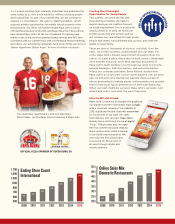Papa Johns 2015 Annual Report Download - page 16
Download and view the complete annual report
Please find page 16 of the 2015 Papa Johns annual report below. You can navigate through the pages in the report by either clicking on the pages listed below, or by using the keyword search tool below to find specific information within the annual report.3
and use. The FOCUS system is also integrated with our digital ordering solutions in all domestic
traditional Papa John’s restaurants, enabling Papa John’s to offer nationwide digital ordering to our
customers.
Strong Franchise System. We are committed to developing and maintaining a strong franchise system by
attracting experienced operators, supporting them to expand and grow their business and monitoring their
compliance with our high standards. We seek to attract franchisees with experience in restaurant or retail
operations and with the financial resources and management capability to open single or multiple
locations. We devote significant resources to provide Papa John’s franchisees with assistance in restaurant
operations, operations training, marketing, site selection and restaurant design.
Our strategy for global unit growth focuses on our strong unit economics model. We strive to eliminate
barriers to expansion in existing international markets, and identify new expansion opportunities. Our
growth strategy varies based on the maturity and penetration of the market and other factors in specific
domestic and international markets, with overall unit growth expected to come increasingly from
international markets.
Restaurant Sales and Investment Costs
We are committed to maintaining strong restaurant unit economics. In 2015, the 667 domestic Company-
owned restaurants included in the full year’s comparable restaurant base generated average annual unit
sales of $1.12 million. Our North American franchise restaurants, which included 2,351 restaurants in
2015, generated average annual unit sales of $858,000. North American franchise restaurant sales are
lower than Company-owned restaurants as a higher percentage of our Company-owned restaurants are
located in more heavily penetrated markets.
With few exceptions, domestic restaurants do not offer a dine-in area, which reduces our restaurant
capital investment. The average cash investment for the 11 domestic traditional Company-owned
restaurants opened during 2015, exclusive of land, was approximately $319,000 per unit, compared to the
$283,000 investment for the 11 domestic traditional units opened in 2014, excluding tenant allowances
that we received. Over the past few years we have experienced an increase in the cost of our new
restaurants primarily as a result of building larger units to accommodate increased sales, an increase in the
cost of certain equipment as a result of technology enhancements, and increased costs to comply with
local regulations.
We define a “traditional” domestic Papa John’s restaurant as a delivery and carryout unit that services a
defined trade area. We consider the location of a traditional restaurant to be important and therefore
devote significant resources to the investigation and evaluation of potential sites. The site selection
process includes a review of trade area demographics, target population density and competitive factors.
A member of our development team inspects each potential domestic Company-owned restaurant location
and substantially all franchised restaurant locations before a site is approved. Papa John’s restaurants are
typically located in strip shopping centers or freestanding buildings that provide visibility, curb appeal
and accessibility. Our restaurant design can be configured to fit a wide variety of building shapes and
sizes, which increases the number of suitable locations for our Company-owned and franchised
restaurants. A typical traditional domestic Papa John’s restaurant averages 1,100 to 1,500 square feet with
visible exterior signage.
“Non-traditional” Papa John’s restaurants generally do not provide delivery service but rather provide
walk-up or carry out service to a captive customer group within a designated facility, such as a food court
at an airport, university or military base or an event-driven service at facilities such as sports stadiums or
entertainment venues. Non-traditional units are designed to fit the unique requirements of the venue and
may not offer the full range of menu items available in our traditional restaurants.
























